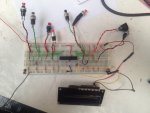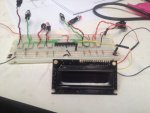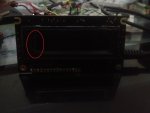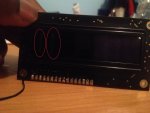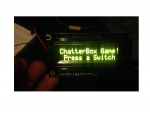Hi guys, I needed some help with an issue I've been having.
I ordered a Budget Serial OLED Module (AXE133Y) from PICAXE. I soldered it on correctly and had powered it with 4.5v to check if it was working. As it worked I decided to work on the program I need for it on my PICAXE 28x2. A few hours later I had decided to power it again this time with the serial port of the module connected to pin 14 (PORT C.3) of the PICAXE. I powered it again and this time the module did not turn on.
Fearing I had done something wrong, I ordered another one, connected it again with the same results. I do not wish to order a 3rd due to money constraints. Also the urgency of this is extremely high as I need to complete my coursework by the 4th of April. Could you please get back to me quickly with how I should proceed, thank you.
The attached items pictures of how I connected my module.
Below is the code I used.
I ordered a Budget Serial OLED Module (AXE133Y) from PICAXE. I soldered it on correctly and had powered it with 4.5v to check if it was working. As it worked I decided to work on the program I need for it on my PICAXE 28x2. A few hours later I had decided to power it again this time with the serial port of the module connected to pin 14 (PORT C.3) of the PICAXE. I powered it again and this time the module did not turn on.
Fearing I had done something wrong, I ordered another one, connected it again with the same results. I do not wish to order a 3rd due to money constraints. Also the urgency of this is extremely high as I need to complete my coursework by the 4th of April. Could you please get back to me quickly with how I should proceed, thank you.
The attached items pictures of how I connected my module.
Below is the code I used.
Code:
Init:
SetFreq M8 'Set Clock Speed to 8Mhz'
Let DirsB =%00000000 'Set Port B to Inputs'
Let DirsC =%11111111 'Set All PORTC to Outputs'
Start:
Let OutpinsB =%00000000 'Set All PORTB to Inputs'
IF pinB.7 = 1 AND pinC.7 = 1 THEN GOSUB S1andS1 'Switch 1 & Switch 1'
IF pinB.7 = 1 AND pinC.6 = 1 THEN GOSUB S1andS2 'Switch 1 & Switch 2'
IF pinB.7 = 1 AND pinC.5 = 1 THEN GOSUB S1andS3 'Switch 1 & Switch 3'
IF pinB.7 = 1 AND pinC.4 = 1 THEN GOSUB S1andS4 'Switch 1 & Switch 4'
IF pinB.6 = 1 AND pinC.7 = 1 THEN GOSUB S2andS1 'Switch 2 & Switch 1'
IF pinB.6 = 1 AND pinC.6 = 1 THEN GOSUB S2andS2 'Switch 2 & Switch 2'
IF pinB.6 = 1 AND pinC.5 = 1 THEN GOSUB S2andS3 'Switch 2 & Switch 3'
IF pinB.6 = 1 AND pinC.4 = 1 THEN GOSUB S2andS4 'Switch 2 & Switch 4'
IF pinB.5 = 1 AND pinC.7 = 1 THEN GOSUB S3andS1 'Switch 3 & Switch 1'
IF pinB.5 = 1 AND pinC.6 = 1 THEN GOSUB S3andS2 'Switch 3 & Switch 2'
IF pinB.5 = 1 AND pinC.5 = 1 THEN GOSUB S3andS3 'Switch 3 & Switch 3'
IF pinB.5 = 1 AND pinC.4 = 1 THEN GOSUB S3andS4 'Switch 3 & Switch 4'
IF pinB.4 = 1 AND pinC.7 = 1 THEN GOSUB S4andS1 'Switch 4 & Switch 1'
IF pinB.4 = 1 AND pinC.6 = 1 THEN GOSUB S4andS2 'Switch 4 & Switch 2'
IF pinB.4 = 1 AND pinC.5 = 1 THEN GOSUB S4andS3 'Switch 4 & Switch 3'
IF pinB.4 = 1 AND pinC.4 = 1 THEN GOSUB S4andS4 'Switch 4 & Switch 4'
S1andS1:
pinC.3 = 1
goto S1andS1Message
S1andS2:
pinC.3 = 1
goto S1andS2Message
S1andS3:
pinC.3 = 1
goto S1andS3Message
S1andS4:
pinC.3 = 1
goto S1andS4Message
S2andS1:
pinC.3 = 1
goto S2andS1Message
S2andS2:
pinC.3 = 1
goto S2andS2Message
S2andS3:
pinC.3 = 1
goto S2andS3Message
S2andS4:
pinC.3 = 1
goto S2andS4Message
S3andS1:
pinC.3 = 1
goto S3andS4Message
S3andS2:
pinC.3 = 1
goto S3andS4Message
S3andS3:
pinC.3 = 1
goto S3andS4Message
S3andS4:
pinC.3 = 1
goto S3andS4Message
S4andS1:
pinC.3 = 1
goto S4andS1Message
S4andS2:
pinC.3 = 1
goto S4andS2Message
S4andS3:
pinC.3 = 1
goto S4andS3Message
S4andS4:
pinC.3 = 1
goto S4andS4Message
S1andS1Message:
serout 7, N2400, (254, 128) ' Blank First Line
serout 7, N2400, ("Switch1 ")
serout 7, N2400, (254, 192) ' Blank Second Line
serout 7, N2400, ("Switch1 ")
S1andS2Message:
serout 7, N2400, (254, 128) ' Blank First Line
serout 7, N2400, ("Switch1 ")
serout 7, N2400, (254, 192) ' Blank Second Line
serout 7, N2400, ("Switch2 ")
S1andS3Message:
serout 7, N2400, (254, 128) ' Blank First Line
serout 7, N2400, ("Switch1 ")
serout 7, N2400, (254, 192) ' Blank Second Line
serout 7, N2400, ("Switch3 ")
S1andS4Message:
serout 7, N2400, (254, 128) ' Blank First Line
serout 7, N2400, ("Switch1 ")
serout 7, N2400, (254, 192) ' Blank Second Line
serout 7, N2400, ("Switch4 ")
S2andS1Message:
serout 7, N2400, (254, 128) ' Blank First Line
serout 7, N2400, ("Switch2 ")
serout 7, N2400, (254, 192) ' Blank Second Line
serout 7, N2400, ("Switch1 ")
S2andS2Message:
serout 7, N2400, (254, 128) ' Blank First Line
serout 7, N2400, ("Switch2 ")
serout 7, N2400, (254, 192) ' Blank Second Line
serout 7, N2400, ("Switch2 ")
S2andS3Message:
serout 7, N2400, (254, 128) ' Blank First Line
serout 7, N2400, ("Switch2 ")
serout 7, N2400, (254, 192) ' Blank Second Line
serout 7, N2400, ("Switch3 ")
S2andS4Message:
serout 7, N2400, (254, 128) ' Blank First Line
serout 7, N2400, ("Switch2 ")
serout 7, N2400, (254, 192) ' Blank Second Line
serout 7, N2400, ("Switch4 ")
S3andS1Message:
serout 7, N2400, (254, 128) ' Blank First Line
serout 7, N2400, ("Switch3 ")
serout 7, N2400, (254, 192) ' Blank Second Line
serout 7, N2400, ("Switch1 ")
S3andS2Message:
serout 7, N2400, (254, 128) ' Blank First Line
serout 7, N2400, ("Switch3 ")
serout 7, N2400, (254, 192) ' Blank Second Line
serout 7, N2400, ("Switch2 ")
S3andS3Message:
serout 7, N2400, (254, 128) ' Blank First Line
serout 7, N2400, ("Switch3 ")
serout 7, N2400, (254, 192) ' Blank Second Line
serout 7, N2400, ("Switch3 ")
S3andS4Message:
serout 7, N2400, (254, 128) ' Blank First Line
serout 7, N2400, ("Switch3 ")
serout 7, N2400, (254, 192) ' Blank Second Line
serout 7, N2400, ("Switch4 ")
S4andS1Message:
serout 7, N2400, (254, 128) ' Blank First Line
serout 7, N2400, ("Switch4 ")
serout 7, N2400, (254, 192) ' Blank Second Line
serout 7, N2400, ("Switch1 ")
S4andS2Message:
serout 7, N2400, (254, 128) ' Blank First Line
serout 7, N2400, ("Switch4 ")
serout 7, N2400, (254, 192) ' Blank Second Line
serout 7, N2400, ("Switch2 ")
S4andS3Message:
serout 7, N2400, (254, 128) ' Blank First Line
serout 7, N2400, ("Switch4 ")
serout 7, N2400, (254, 192) ' Blank Second Line
serout 7, N2400, ("Switch3 ")
S4andS4Message:
serout 7, N2400, (254, 128) ' Blank First Line
serout 7, N2400, ("Switch4 ")
serout 7, N2400, (254, 192) ' Blank Second Line
serout 7, N2400, ("Switch4 ")Attachments
-
638.3 KB Views: 44
-
593.4 KB Views: 56

